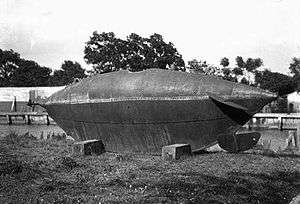Bayou St. John submarine
The Bayou St. John Confederate Submarine is an early military submarine built for use by the Confederate States of America during the American Civil War.
 The submarine on display beside Bayou St. John, 1890s | |
| History | |
|---|---|
| Fate: | Scuttled, c. April 1862 |
| Status: | Museum ship |
| General characteristics | |
| Type: | Submarine |
| Length: | 20 ft (6.1 m) |
| Beam: | 3 ft (0.91 m) |
| Height: | 6 ft (1.8 m) |
| Propulsion: | Hand-cranked propeller |
| Armament: | Spar torpedo (presumed) |

Description
The submarine is constructed of riveted iron, 20 feet (6.1 m) long, 3 feet (0.91 m) wide and 6 feet (1.8 m) deep, with a hand-cranked propeller.
History
No period documentation for the submarine is known to exist, and its original name and many details about it remain unknown. The submarine was rediscovered in 1878 during dredging of Bayou St. John where it joins Lake Pontchartrain in New Orleans, Louisiana, where the submarine was presumably scuttled to prevent it falling into Union hands after the capture of New Orleans (see also: New Orleans in the American Civil War). It was put on display beside the Bayou at Spanish Fort Amusement Park as a curiosity, incorrectly identified as the Confederate submarine Pioneer.
The traditional identification as the Pioneer was not questioned seriously until historical research in the late 20th century showed the Pioneer to be of a different design than the one retrieved from Bayou St. John. The Bayou submarine and the Pioneer may have undergone trials at about the same time, and confusion of the two may date back to contemporary accounts; it is not clear which one was constructed first.
In 1908 the submarine was moved to the grounds of Camp Nicholls Confederate Home on Moss Street, beside Bayou St. John. About this time, the interior of the submarine was filled with concrete in an attempt at preservation that later generations of conservators found questionable.
In 1942 the submarine was acquired by the Louisiana State Museum and moved to Jackson Square. After being in various displays around the Square it was placed in the shelter of the arcade on the ground floor of the Presbytere in 1957, where it would remain until 1999.
In 1999 the submarine was transported to Baton Rouge, where the old concrete was removed as part of major restoration work. Afterwards, the submarine was placed on display at the Capitol Park Museum - Baton Rouge.
References
External links
| Wikimedia Commons has media related to Bayou St. John Confederate Submarine. |